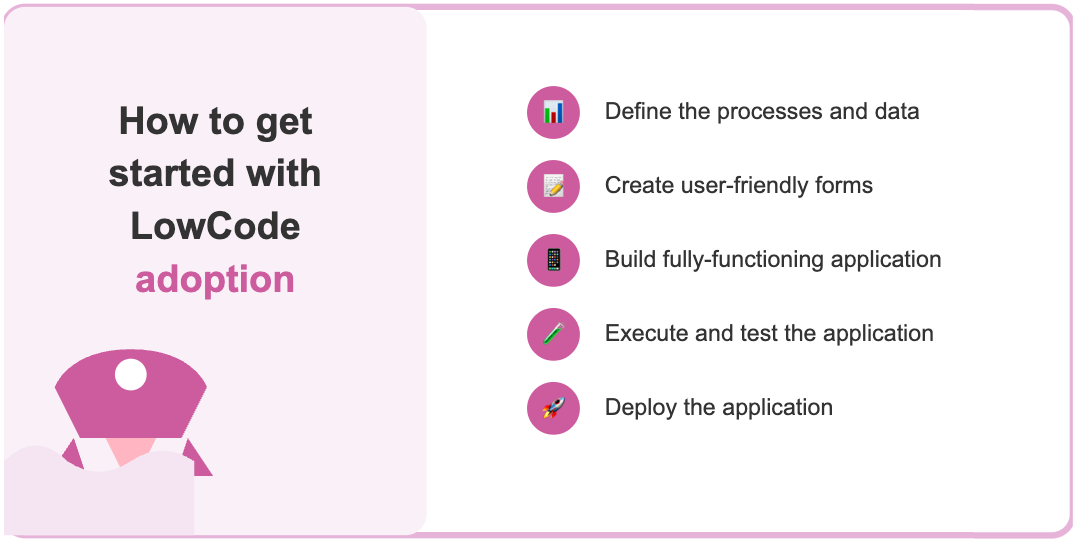

10 Critical Business Problems Solved by Modern LowCode Development Platforms
Published on March 25, 2025
Written by Jaren Hidalgo · 9 minute read
In today's rapidly evolving business landscape, organizations face constant pressure to innovate quickly while keeping costs down. At Kreante, we've seen firsthand how digital transformation tools are revolutionizing the way businesses approach their development process and solve critical business problems.
Market pressure continue to drive digital transformation initiatives, with many businesses seeking ways to accelerate their development process without sacrificing quality. The COVID-19 pandemic further pushed companies to fast-track their transformation using digital tools and software solutions that promote collaboration.
However, business transformation isn't without challenges. According to recent studies, many transformation projects fail, often due to insufficient capabilities across the organization. It's especially difficult when IT departments alone manage the process, as they typically face significant backlogs and time-consuming tasks.
Key Takeaways
LowCode development platforms simplify app creation, making it accessible for both technical and non-technical users through intuitive interfaces and pre-built templates.
These platforms significantly accelerate application deployment, reducing development time from months to days, which is crucial for staying competitive.
LowCode platforms enhance collaboration between IT and business teams, empowering organizations to innovate and adapt quickly to market changes.
What is LowCode?

LowCode is a revolutionary approach to software development that enables developers to create applications with minimal hand-coding. By introducing a user-friendly, drag-and-drop development environment, LowCode platforms make app development accessible to both novice coders and seasoned developers. These platforms provide a visual development environment complete with pre-built components, templates, and automation capabilities. This allows developers to create comprehensive applications featuring modern user interfaces, seamless integrations, robust data management, and complex logic much faster than traditional development methods. By leveraging LowCode platforms, businesses can accelerate their development process, respond to market demands swiftly, and innovate without the typical constraints of extensive coding.
Need to develop apps faster and at lower costs? A LowCode development platform could be your answer. This article covers the top 10 business challenges that these platforms solve, making app creation more efficient and accessible. Read on to see how LowCode platforms can transform your development process.
1. Slow Deployment Time
Traditional software development cycles can be tremendously time-consuming, but a rapid application development tool dramatically reduces this timeframe to days or even hours. Industry research has shown that the RAD methodology, which stands for Rapid Application Development, is a form of agile software development that prioritizes rapid prototyping and iterative delivery. It can speed up software development by up to 10 times. With intuitive interfaces and pre-built templates, we help businesses respond to market changes much faster than conventional approaches.
2. High Development Costs
By empowering non-developers to build their own applications, LowCode development platforms substantially lower costs. At Kreante, we’ve seen companies save significantly on software engineering expenses by allowing team members with minimal technical expertise to create applications. For example, financial professionals can build their own digital accounting tools or payroll management tools with deep domain knowledge.
3. Security Concerns and Risk Mitigation
Traditional app development doesn't always prioritize security from the ground up. Modern LowCode platforms like those we implement at Kreante have robust security built-in. They provide proper governance and control mechanisms before development begins, with professional oversight of access controls and data management—critical considerations for successful projects.
4. Minimal Control Over App Development
Organizations without standardized platforms often struggle with shadow IT issues, where employees implement unauthorized software solutions. Our software development approach gives departments complete control over the app development ecosystem, ensuring all new processes align with company requirements, similar to how Microsoft Teams enables controlled collaboration.
5. Lack of Business Flexibility
Market conditions change rapidly, and businesses need to adapt just as quickly to ensure their business processes remain efficient. The right LowCode platform enables enterprises to release new solutions faster, allowing them to respond promptly to marketplace changes. At Kreante, we’ve helped clients build better prototypes, gather feedback faster, and make adjustments in real-time—all essential for maintaining business agility and enhancing customer experience.
6. Decreased Productivity and Repetitive Tasks
Organizational silos kill productivity. LowCode platforms break down these barriers by enabling team members to build applications that automate repetitive tasks. The capabilities in these platforms eliminate tedious manual work that slows down development, boosting overall productivity. Our clients regularly see their teams become more efficient regardless of their technical background.
7. Coding expertise: a must in traditional Software engineering
Traditional software engineering requires significant coding skills and knowledge. LowCode technology removes this complexity, allowing business users with minimal programming knowledge to build robust applications. By introducing a user-friendly, drag-and-drop interface, LowCode platforms make app development accessible to both novice coders and seasoned developers. Originally conceived by James Martin as part of the rapid application development (RAD) approach, today’s platforms have evolved to offer sophisticated features while maintaining simplicity.
At Kreante, we provide tools and templates that help clients define key components and deliver viable applications that meet user needs and requirements in real-time, freeing experienced developers to focus on more complex projects that require greater technical expertise.
8. Challenges of Integrating with Legacy Systems
Modern business requires seamless connections between applications. Unlike traditional development platforms that often operate in isolation, LowCode platforms support easy integration with tools like Google Drive through industry-standard interfaces. This integration is crucial for managing data effectively in the digital workplace, a key benefit we emphasize in our solutions.
9. Limited Customization Options
Large enterprises need tailored solutions that can evolve with their needs. LowCode tools enable rapid prototyping of customized applications that can be easily updated even after deployment. At Kreante, we help clients build flexible solutions that adapt to specific requirements, ensuring long-term value from their technology investments for their next project.
10. Complex Analytics Processes
In today's data-driven world, quickly extracting actionable insights through predictive analytics is essential. LowCode platforms offer intuitive dashboards and visualization tools that make data comprehension straightforward. We've helped numerous clients leverage artificial intelligence capabilities to make better decisions faster, turning data into a genuine competitive advantage for digital marketing and other business functions.
Benefits of LowCode Platforms

LowCode platforms offer a multitude of benefits that can transform the way businesses approach software development:
Accelerated Development Time: LowCode platforms significantly reduce the time required to build applications, enabling developers to deliver solutions at a much faster pace. What previously took months can now be accomplished in just days, accelerating the overall development speed. This rapid turnaround is crucial in today’s competitive market, where time-to-market can make or break a product’s success.
Reduced Costs: LowCode platforms lower initial costs for setup and maintenance, leading to significant savings in application creation. Also, by minimizing the need for extensive coding, LowCode platforms reduce the hours developers spend on each project, leading to substantial cost savings.
Empowers Business Users: With user-friendly interfaces, LowCode platforms allow non-technical users to participate in the development process, fostering greater collaboration and productivity.
Enhanced Flexibility: These platforms provide tools for easily updating and scaling applications as business needs evolve, ensuring that solutions remain relevant and effective.
Improved IT and Business Collaboration: Simplifying the development process, LowCode platforms facilitate closer collaboration between IT and business units, ensuring that solutions align with business requirements.
Choosing the Right LowCode Platform

Selecting the right LowCode platform is crucial for maximizing its benefits. Here are key factors to consider:
Core LowCode Platform Functionality: Evaluate the platform’s visual development capabilities, automation features, and pre-built components to ensure it meets your development needs.
Additional Standout Features: Look for support for AI, machine learning, and predictive analytics, as well as robust integration capabilities with other tools and systems.
Usability: Assess the platform’s user interface and user experience to ensure it is intuitive and easy to use for both technical and non-technical users.
Onboarding: Consider the platform’s onboarding process, including the availability of training resources, documentation, and support to help your team get up to speed quickly.
Customer Support: Evaluate the platform’s customer support options, including email, phone, and online resources, to ensure you have access to help when needed.
Value For Money: Ensure the platform’s pricing model aligns with your organization’s budget and provides a good return on investment.
Customer Reviews: Research the platform’s reputation by reading customer reviews and testimonials to ensure it has a proven track record of success.
Implementing LowCode in Your Organization

Implementing LowCode in your organization involves several strategic steps:
Identifying Business Needs: Start by determining the specific business problems that LowCode can solve and identify the key stakeholders and users who will be involved in the development process.
Choosing the Right Platform: Select a LowCode platform that meets your organization’s needs based on the factors outlined above.
Developing a Strategy: Create a comprehensive strategy for implementing LowCode, including a roadmap for adoption, training, and support.
Providing Training and Support: Offer training and support for developers and users to ensure they have the skills and knowledge needed to use the platform effectively.
Monitoring and Evaluating: Continuously monitor and evaluate the success of the LowCode implementation, identifying areas for improvement and optimizing the platform for future use.
By following these steps, your organization can successfully start a project by integrating NoCode/LowCode platforms into your development process, driving innovation and efficiency while reducing costs and complexity.
The Future of LowCode Development

LowCode technology is projected to grow at a rate of 20%, reflecting its increasing adoption and significance. According to Gartner, in their reports, the worldwide LowCode development technologies market is expected to expand significantly. Their "Magic Quadrant for Enterprise
Industry experts predict that by the end of 2025, the majority of applications will be built using LowCode platforms. This projection underscores the growing recognition of LowCode's value in driving innovation, increasing revenue, and enhancing customer experience.
Summary
LowCode development platforms are revolutionizing the way businesses approach software development. By offering tools that simplify and expedite the development process, these platforms address critical business challenges and enhance digital transformation efforts.
As we look to the future, the adoption of LowCode platforms will only continue to grow, driving innovation and enabling businesses to respond more quickly to changing market demands. The time to explore and invest in LowCode development is now.
At Kreante, we're committed to helping organizations harness the power of LowCode and NoCode solutions to overcome these common business challenges. Our expertise in implementing these platforms enables clients to accelerate their digital transformation journeys while reducing costs and complexity.
Ready to explore how LowCode platforms can address your business problems? Contact Kreante today to learn more about our approach and solutions. For more insights and updates on LowCode technology and digital transformation, be sure to visit our blog where we regularly share valuable content to help you stay ahead in the ever-evolving digital landscape.
Frequently Asked Questions
What are LowCode development platforms?
LowCode development platforms empower you to create applications easily with minimal coding, using a user-friendly graphical interface. This approach accelerates development and makes app creation accessible to everyone!
What are the key features of LowCode platforms?
LowCode platforms excel with user-friendly drag-and-drop interfaces, visual modeling tools, pre-built templates, and seamless integration capabilities. These features empower anyone to build applications quickly and efficiently!
How do LowCode platforms enhance digital transformation?
LowCode platforms significantly accelerate development, allowing for rapid prototyping and quick adaptation to market changes, which truly enhances your digital transformation journey. Embracing these platforms can put you ahead in today's fast-paced environment!
What are the benefits of using LowCode development platforms?
Using LowCode development platforms greatly reduces development time and costs while making it accessible for non-technical users, fostering collaboration between IT and business teams. Embrace this approach for a more efficient and inclusive development process!
How do LowCode platforms compare to traditional development methods?
LowCode platforms accelerate development and simplify maintenance, making them an excellent choice for many projects. While they may offer less customization for complex needs, their speed and efficiency can be a game-changer for many teams.
Are you facing any of these challenges in your organization? Let us know by reaching out directly to us and let's discuss how our LowCode solutions can help with your development process.










